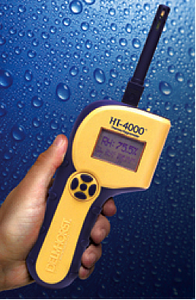Seasoned experts know the tools of the restoration trade, which includes accurate moisture meters. These compact, innovative devices can detect relative humidity and moisture content with pinpoint accuracy, and have been adopted by restoration experts across the globe because of this.
For a restoration professional seeking to improve their credibility and reputation to increase their business, using the right industrial moisture meters for their projects is essential.
What Restoration Specialists Should do
The very first thing any restoration contractor seeking to boost their professional reputation should consider doing is to invest in a professional-grade moisture meter. These meters, with their incredible ability to identify moisture pockets and concentrations within building materials, are necessary tools to verify that the structure is dry and thereby greatly improve a customer’s opinion of the contractor’s work.
How is this possible with a moisture detector? Today’s innovative moisture meters allow restoration specialists to provide proof of moisture in building materials, and they can also identify problem areas within various parts of the structure itself.
If you are a restoration specialist looking to improve your reputation with valuable clients and provide dependable and efficient services, we suggest considering the added benefits moisture meter technology can bring to your business.
Why They Should do it
But what does this mean for restoration professionals, specifically?
Well, for starters, the restoration contractor can monitor the progress of the dry-out process in wood, drywall, concrete other building materials during the restoration process. This provides ongoing reliability and assurance for each step of their dry-out operations. When using moisture meters in their work, restoration contractors can confidently attest to the quality of their work and rest easy in the knowledge that they’ve used the best tools available for a long-lasting, professional job.
For the best evaluation of drying processes, it is imperative that contractors measure the moisture of water-damaged materials upon arrival at the job site. Almost any building material affected by water damage can be scanned for moisture with a moisture meter, including wood, concrete, drywall, insulation, ceilings and property foundations.
Many restoration experts use moisture meters paired with infrared and thermal imaging cameras to identify areas of moisture content. This is because of the correlation between higher temperatures and high moisture content. When dealing with water damage and severe home damage, there is nothing more important to a homeowner than speed and accuracy, the two components of an efficient restoration operation; they simply want to return to their normal lives.
How Moisture Meters Work
There are two types of moisture meters available for use in restoration applications: pin-type meters and pin-less meters. Each meter has a specific function during restoration jobs, but an especially knowledgeable restoration expert understands and might wish to use both in their operations.
Pin-type moisture meters use the principle of electrical resistance, where the building materials of the object being inspected act as an element in an electrical circuit. Using a set of insulated contact pins, these meters can detect the precise location of moisture. This type of meter delivers the most focused and accurate readings. One notable advantage of pin-type moisture meters is that they can identify “hidden” moisture behind walls or in the subfloor.
Pin-less moisture meters, on the other hand, use radio frequency to scan more general areas within a home. Restoration professionals use these meters to scan large areas quickly, and identify the general location of moisture for further inspection. This allows for a very rapid home inspection, after which pin-type meters are used to obtain more precise readings. A pin-less moisture meter is ideal for quick, if less exacting, readings of a building material’s moisture, and does not require restoration specialists to punch holes in targeted surfaces.
 Thermo-hygrometers measure the ambient moisture conditions of a given room in a building. These devices can be used to establish the risk of moisture damage to a large portion of the structure, or to verify that the dry-out process is going according to schedule.
Thermo-hygrometers measure the ambient moisture conditions of a given room in a building. These devices can be used to establish the risk of moisture damage to a large portion of the structure, or to verify that the dry-out process is going according to schedule.
Additionally, thermo-hygrometers may be used to measure the temperature of ambient conditions, and on the output of a dehumidifier. Better quality thermo-hygrometers also calculate GPP (Grains Per Pound).
Their meter options
There is an incredible variety of moisture meters available for the restoration industry today. Here at Delmhorst Instrument Co., we manufacture professional quality moisture meters perfectly suited for all of your restoration needs. Each model comes with its own special features and technical capabilities, and can prove to be an invaluable asset in any restoration professional’s toolkit.
To learn more about how moisture meter technology can improve your reputation as a restoration professional, contact us today. Our moisture detection specialists can help you find what kind of moisture meter is ideal for your service applications.

Comments